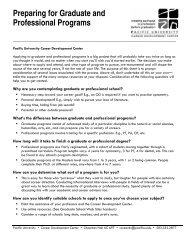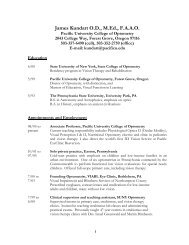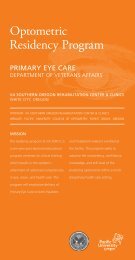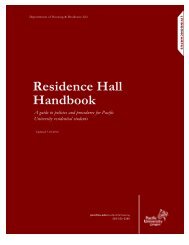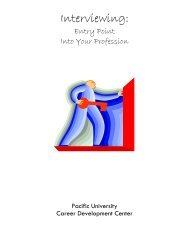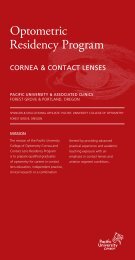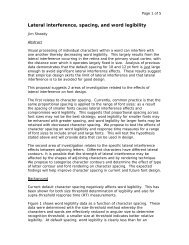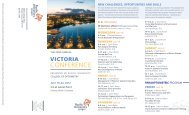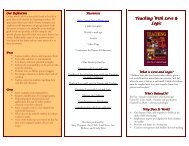Brand Standards - Pacific University
Brand Standards - Pacific University
Brand Standards - Pacific University
You also want an ePaper? Increase the reach of your titles
YUMPU automatically turns print PDFs into web optimized ePapers that Google loves.
<strong>Brand</strong> <strong>Standards</strong><br />
version 3.0<br />
REV. 10/11
Table of Contents<br />
<strong>Pacific</strong> <strong>University</strong> Messaging..................................... 1<br />
<strong>Pacific</strong> <strong>University</strong><br />
<strong>Brand</strong> <strong>Standards</strong><br />
Our brand is an important asset to the students, trustees, faculty,<br />
staff, volunteers, alumni and supporters of <strong>Pacific</strong> <strong>University</strong>. We<br />
communicate our brand identity by presenting an engaging and<br />
consistent graphic and editorial identity. This approach is essential<br />
to establishing a strong institutional brand presence that also helps<br />
differentiate us from other universities and position us in a highly<br />
competitive market.<br />
The unified identity system outlined in our <strong>Pacific</strong> <strong>University</strong><br />
<strong>Brand</strong> <strong>Standards</strong> is for use by the entire <strong>Pacific</strong> <strong>University</strong> community.<br />
This provides a framework that promotes consistency in our<br />
outreach efforts and outlines the standards for use of our visual<br />
symbols and editorial style. This includes the <strong>Pacific</strong> <strong>University</strong> logo,<br />
logo usage in general, the Boxer color palette, fonts and messaging.<br />
It is imperative we adhere to these standards online and in<br />
print at <strong>Pacific</strong> <strong>University</strong> throughout our campuses, departments,<br />
programs, schools, colleges, centers and institutes.<br />
By using these standards, you help us visually define the<br />
<strong>University</strong> in a strong, consistent manner that will be instantly<br />
recognizable. These efforts support and complement the tradition<br />
of <strong>Pacific</strong> <strong>University</strong>, as well as the quality of our teaching, research<br />
and service.<br />
Please join us in proudly incorporating the <strong>Pacific</strong> <strong>University</strong><br />
<strong>Brand</strong> <strong>Standards</strong> into every facet of our marketing and<br />
communications efforts. Your continued support helps strengthen<br />
<strong>Pacific</strong> <strong>University</strong> and our brand.<br />
Tammy Spencer<br />
Associate Vice President of Marketing and Communications<br />
UNIVERSITY ADVANCEMENT<br />
Integrated Marketing Strategy...................................2<br />
<strong>Pacific</strong> <strong>University</strong> Logo..............................................3<br />
Logo Size & Spacial Limitations................................4<br />
Logo Color Configuration...........................................5<br />
Backgrounds & Tier Logos........................................ 6<br />
Apparel......................................................................7<br />
Logo File Names & Trademark Logo......................... 8<br />
Alternate Logo Use................................................... 9<br />
Secondary Graphic Elements.................................. 10<br />
Block P & <strong>University</strong> Seal......................................... 11<br />
Color Palettes & Color Systems Defined.................. 12<br />
Trademark & Commercial Use................................ 14<br />
<strong>University</strong> Letterhead.............................................. 14<br />
Electronic Templates .............................................. 15<br />
Environmental Commitment................................... 15<br />
Freelance & Translation Policies.............................. 16<br />
Multimedia Guidelines.............................................17<br />
Internet <strong>Standards</strong> & Guidelines............................. 18<br />
CANS Postings.........................................................20<br />
Email Marketing......................................................20<br />
QR Codes.................................................................20<br />
Social Media...........................................................20<br />
Font Use.................................................................. 21<br />
Mailing Guidelines..................................................22<br />
Editorial <strong>Standards</strong>..................................................23
PACIFIC UNIVERSITY BRAND STANDARDS<br />
<strong>Pacific</strong> <strong>University</strong> Messaging<br />
AN OVERVIEW OF PACIFIC’S HISTORY AND OFFERINGS<br />
Below is sample messaging that may come in handy for use as boilerplate in <strong>University</strong> publications.<br />
<strong>Pacific</strong> <strong>University</strong>, founded in 1849, offers a tradition rich in liberal arts and teaching, as well as<br />
evidence-based healthcare curricula for scholars of all backgrounds.<br />
Rooted in Forest Grove, Oregon with additional campuses in Hillsboro and Eugene, <strong>Pacific</strong> remains a<br />
small, close-knit community where big ideas develop through experiential learning, diverse<br />
perspectives and civic engagement.<br />
At the historic Forest Grove campus, students pursue bachelor’s, graduate and professional degrees<br />
within the colleges of Arts & Sciences, Education and Optometry.<br />
The Eugene campus also offers undergraduate and graduate degrees in Education, and the<br />
state-of-the-art Health Professions Campus in Hillsboro houses the College of Health Professions’<br />
graduate and professional programs.<br />
Additionally, the <strong>University</strong> administers affordable healthcare clinics and services throughout the<br />
Portland metropolitan region.<br />
<strong>Pacific</strong>’s commitment to the community stems from close collaboration between students and<br />
faculty, who passionately embark together and individually on service learning and research<br />
opportunities, international education and co-curricular activities.<br />
1
PACIFIC UNIVERSITY BRAND STANDARDS<br />
COLLEGE OF EDUCATION | BUS SUPER TAILS<br />
6201<br />
think. see. teach. heal.<br />
INTEGRATED MARKETING STRATEGY<br />
In 2010, <strong>Pacific</strong> launched an integrated marketing strategy that<br />
introduces the <strong>University</strong> brand to the Portland Metro area via<br />
a comprehensive, consistent and engaging campaign.<br />
Four keywords (think, see, teach, heal), styled consistenly<br />
PACU_IMSSuperTail_2011_SALEM | SALEM QTY 1<br />
865404<br />
and accompanied by engaging campus photography, lead the<br />
campaign and functionally represent our four colleges. An<br />
overarching keyword—discover—is used to communicate the<br />
larger <strong>University</strong> messaging. Perhaps more symbolically, these<br />
keywords and imagery also give the viewer insight into what<br />
they might expect during their experience with the <strong>University</strong><br />
and beyond.<br />
PACU_IMSSuperTail_2011_EUGENE | EUGENE QTY 3<br />
865405<br />
The multi-channel, offline and online, campaign is<br />
managed through the Office of Marketing & Communications.<br />
Results and guidelines for use are available upon request.<br />
2
PACIFIC UNIVERSITY BRAND STANDARDS<br />
<strong>Pacific</strong> <strong>University</strong> Logo<br />
As the primary visual identifier for the institution, the <strong>Pacific</strong> <strong>University</strong> logo is used<br />
in all development, promotional, marketing, recruitment and outreach materials<br />
including, but not limited to, print, apparel and online communications. For more<br />
information on Trademark and Commercial use of the logo, see page 12.<br />
Use only the provided files of the original mark. Under no circumstances should<br />
the logo be redrawn, reproportioned or modified in any manner. Elements of the<br />
logo should not be separated or repositioned. Do not use dropshadows, bevels, 3-D<br />
effects, animation, embosses, glows or outlines. See page 7 for Alternate Logo Use.<br />
NOTE | Electronic files of the logo are available on the website at<br />
pacificu.edu/marcom. See page 6 for specific file names.<br />
YES!<br />
NO!<br />
Do not reposition or rearrange<br />
NO!<br />
Do not Stretch<br />
“P”<br />
“P”<br />
“P”<br />
“P” Letter Height<br />
“P”<br />
“P” Letter Height<br />
“P”<br />
“P”<br />
“P”<br />
“P”<br />
3
PACIFIC UNIVERSITY BRAND STANDARDS<br />
3/4"<br />
Logo Size & Spacial Limitations<br />
SIZE | Consider the guide below to ensure that the <strong>Pacific</strong> <strong>University</strong><br />
signature (logo and logotype) is legible and prominent.<br />
PAGE SIZE<br />
SUGGESTED LOGO SIZE<br />
Up to–6”x 9” 3/4”–1”<br />
Up to–8.5”x 11” 3/4”–1 1/2”<br />
Up to–12x18” 1”–2”<br />
CLEAR SPACE | The <strong>Pacific</strong> <strong>University</strong> logo must be given sufficient visual<br />
space so that its impact is not degraded. Items such as text, images<br />
or graphic elements should be kept away from the logo by a minimum<br />
distance of the height of the “P.”<br />
PLACEMENT | The <strong>University</strong> logo looks best when placed in the top or<br />
bottom right-hand corner of a layout. Remember to maintain “P” space.<br />
1"<br />
1 1/2"<br />
EXCEPTIONS | When working with a very small format (smaller than<br />
3/4”) such as on pens, or a very large format (larger than 12” x 16”) for<br />
items such as posters, signs and event marketing, please contact<br />
Marketing & Communications for project-specific guidelines.<br />
2”<br />
“P”<br />
“P” Letter Height<br />
“P”<br />
“P”<br />
NOTE | The above images are visual<br />
examples only. Logo may be reproduced at<br />
any size in proper proportions.<br />
“P”<br />
4
PACIFIC UNIVERSITY BRAND STANDARDS<br />
Color Configuration<br />
The electronic files for the <strong>Pacific</strong> <strong>University</strong> logo are provided<br />
in multiple color configurations—black, spot/Pantone Matching<br />
System (PMS) colors, CMYK/four-color process and white (for<br />
reversing out of a dark background). Logo file names are<br />
included on page 6. Please do not change the color of the logo.<br />
P”<br />
YES!<br />
NO! Do not recolor.<br />
5
PACIFIC UNIVERSITY BRAND STANDARDS<br />
Backgrounds<br />
The white/reverse logo is intended for use on colored backgrounds. There may also be<br />
instances where the logo may need to be used on a photograph. The color or black version<br />
of the logo may be used on light photographs, and the white/reverse version on dark<br />
photographs. Be sure that the logo is placed in an area of the photograph that provides<br />
sufficient contrast so that the appearance of the logo is not diminished in any way.<br />
Tier Logos<br />
Customized logos are available for use in letterhead from Marketing & Communications (MarCom) allowing colleges,<br />
schools, departments, programs, centers and institutes to combine their name with the <strong>University</strong> logo. The tiered<br />
logo system allows for brand consistency in an increasingly competetive market, as such, the creation of personalized<br />
logos outside of the tier logo concept is not an option. Do not attempt to create your own department logo.<br />
All logo reproduction rules (see page 1) apply when using custom logos. Customized logos are not to be used on<br />
<strong>University</strong> website(s). Contact MarCom for additional information.<br />
BERGLUND CENTER<br />
for INTERNET STUDIES<br />
6
PACIFIC UNIVERSITY BRAND STANDARDS<br />
Apparel<br />
The <strong>University</strong> logo must appear in its entirety on all <strong>Pacific</strong><br />
<strong>University</strong> apparel.<br />
NOTE | Apparel must be purchased from licensed vendors. For a<br />
list of approved vendors visit pacificu.edu/marcom/resources.<br />
While some cases may warrant event-specific artwork to be<br />
printed on apparel, the <strong>Pacific</strong> <strong>University</strong> logo (available at pacificu.<br />
edu/marcom) must also appear somewhere on the product—<br />
for example, on a shirt the logo may be placed on the chest<br />
pocket, sleeve, back of the neck or other location in addition to<br />
any primary artwork. The logo is not to be altered, stretched or<br />
distorted. Do not create primary artwork that could be viewed<br />
as an alternate logo for the program, club or group. Preferred<br />
apparel colors are red + gray, black, white or red.<br />
MarCom is happy to review and provide feedback prior to<br />
ordering to help ensure that there are no delays in the<br />
trademark/licensing process once your order is placed.<br />
Orientation 2010 T-SHIRT<br />
7
PACIFIC UNIVERSITY BRAND STANDARDS<br />
TradeMark (TM) Logo<br />
Retail vendors who sell <strong>Pacific</strong> <strong>University</strong><br />
logo items are required to use the TM<br />
signature and must get permission from<br />
Marketing & Communications. See page 12<br />
for additional information. A list of licensed<br />
vendors is available at pacificu.edu/marcom.<br />
Logo File Names<br />
STANDARD LOGO | Electronic files of the logo are available at<br />
pacificu.edu/marcom.<br />
EPS | Vector files are best for print and are scalable in size.<br />
Black<br />
RGB (On-screen)<br />
CMYK (4-color process)<br />
White (reversed)<br />
2-color (PMS)<br />
PacU_Logo_Blk.eps<br />
PacU_Logo_RGB.eps<br />
PacU_Logo_CMYK.eps<br />
PacU_Logo_WhiteRev.eps<br />
PacU_Logo_2c.eps<br />
JPG | For print or web. To avoid pixelation, JPG files can be reduced in<br />
size but not enlarged.<br />
Black<br />
RGB (On-screen)<br />
CMYK (4-color process)<br />
PacU_Logo_Blk.jpg<br />
PacU_Logo_RGB.jpg<br />
PacU_Logo_CMYK.jpg<br />
PNG | For print or web. Best when a transparent background is needed. PNG<br />
files also work well for placement in Word, PowerPoint and other Microsoft<br />
Office documents. Like the JPG versions, a PNG can be reduced in size without<br />
losing clarity, but not enlarged.<br />
White (reversed)<br />
PacU_Logo_WhiteRev.png<br />
8
PACIFIC UNIVERSITY BRAND STANDARDS<br />
Alternate Logo Use<br />
SPECIAL CONSIDERATION ONLY<br />
THE BOXER | In very limited instances, it may be appropriate to use the “Boxer” symbol<br />
without attaching the logotype. This should only be done when the complete logo is printed<br />
elsewhere on the same piece. For example, on a T-shirt when the logo is also on the sleeve or<br />
on the gym floor of the Stoller Center where there are other visible instances of the logo<br />
(scoreboard, banners in the arena, etc.). Approval from MarCom is required.<br />
HORIZONTAL & VERTICAL LOGOS | When the standard logo doesn’t fit the layout, the<br />
horizontal or vertical logo can be used. If in question, ask the <strong>University</strong> art director or<br />
creative marketing director.<br />
ANIMATION | Please refrain from animating the logo (i.e. in video or on web pages).<br />
NO!<br />
Do not change direction of Boxer.<br />
9
PACIFIC UNIVERSITY BRAND STANDARDS<br />
Secondary Graphic Elements<br />
SPIRIT LINES | Spirit Lines are a graphic identity symbol derived<br />
from elements of the Boxer logo. This symbol is to be used as a<br />
subtle background texture on large fields of color or on photographs.<br />
No more than a 10 percent opacity is recommended. The Spirit Lines<br />
are intended to enhance your materials. They are not to be used as a<br />
replacement for the logo. If in question, contact the <strong>University</strong> art<br />
director or creative marketing director.<br />
BOXER | <strong>Pacific</strong> <strong>University</strong>’s mascot. Print and web materials<br />
that utilize this artwork are generally of a casual nature and<br />
communicate school spirit. Boxer is most often used by student<br />
groups and alumni organizations.<br />
10
PACIFIC UNIVERSITY BRAND STANDARDS<br />
Block P<br />
SECONDARY LOGO | The secondary block “P” logo may be used<br />
within the Athletic Department and the <strong>University</strong> Bookstore only.<br />
The <strong>University</strong> Seal<br />
The seal is the traditional legal signature or imprimatur for the <strong>University</strong>, representing<br />
official sanctioning by the institution. Use of the seal is reserved for the President’s office<br />
and for formal academic and <strong>University</strong> business such as authenticating diplomas,<br />
transcripts and other official documents—i.e., commencement awards and materials.<br />
Use of the seal is limited and should not be used as a substitute for the <strong>University</strong> logo.<br />
11
PACIFIC UNIVERSITY BRAND STANDARDS<br />
Color Palette<br />
Using consistent colors in our visual communications across print and web<br />
strengthens the <strong>Pacific</strong> <strong>University</strong> identity.<br />
NOTE | For apparel and logo gear, the primary colors (plus white) should<br />
be used whenever possible.<br />
Color Systems Defined<br />
PANTONE MATCHING SYSTEM (PMS) | color system used for print reproduction.<br />
CMYK, 4COLOR | four colors combined to create full-color print reproduction.<br />
C=Cyan M=Magenta Y=Yellow K=Black<br />
RGB | three colors combined for computer monitor full-color viewing.<br />
R=Red G=Green B=Blue<br />
HEX | a six-digit alpha numeric representation of color for use on the web,<br />
derived from RGB color values.<br />
Primary Colors<br />
The primary colors for <strong>Pacific</strong> <strong>University</strong> are red, black and grey. These colors<br />
create the dominant color scheme for all print and web communication.<br />
Boxer Red<br />
Pantone 1805<br />
C.0 M.100 Y.100 K.28<br />
R.165 G.31 B.42<br />
HEX #990000<br />
Boxer Black<br />
Pantone Black 6<br />
C.50 M.40 Y.40 K.100<br />
R.0 G.0 B.0<br />
HEX #000000<br />
Boxer Grey<br />
Pantone 431<br />
C.20 M.10 Y.0 K.65<br />
R.87 G.90 B.93<br />
HEX #666666<br />
12
PACIFIC UNIVERSITY BRAND STANDARDS<br />
Secondary Colors<br />
In some instances it may be appropriate to accent the primary colors with additional colors to add interest or to create visual<br />
differentiation. In these instances, the secondary color palette may be used, but only in conjunction with the primary colors.<br />
NOTE | The colors shown here may not be fully accurate to the Pantone color standards and will vary on desktop printers.<br />
Contemporary Bright<br />
SECONDARY COLORS | Most often used for Arts & Sciences and more casual materials.<br />
Boxer Indigo<br />
Pantone 5265<br />
C.92 M.87 Y.26 K.12<br />
R.27 G.66 B.152<br />
Boxer Leaf Green<br />
Pantone 583<br />
C.34 M.12 Y.100 K.0<br />
R.181 G.191 B.53<br />
Boxer Gold<br />
Pantone 124<br />
C.7 M.31 Y.100 K.0<br />
R.253 G.186 B.18<br />
Boxer Blue<br />
Pantone 549<br />
C.67 M.27 Y.15 K.2<br />
R.80 G.145 B.205<br />
Boxer Lime Green<br />
Pantone 381<br />
C.20 M.0 Y.91 K.0<br />
R.214 G.224 B.61<br />
Boxer Tangerine<br />
Pantone 144<br />
C.0 M.62 Y.100 K.0<br />
R.245 G.126 B.32<br />
Classic Muted Palette<br />
SECONDARY COLORS | Most often used for professional programs and by the President’s and development offices.<br />
Boxer Navy<br />
Pantone 541<br />
C.90 M.70 Y.15 K5<br />
R.46 G.87 B.145<br />
Boxer Teal<br />
Pantone 337<br />
C.31 M.0 Y.20 K.0<br />
R.175 G.221 B.210<br />
Boxer Chambrey<br />
Pantone 644<br />
C.52 M.6 Y.0 K.25<br />
R.86 G.155 B.190<br />
Boxer Olive Green<br />
Pantone 582<br />
C.49 M.33 Y.100 K.10<br />
R.135 G.138 B.53<br />
Boxer Burnt Orange<br />
Pantone 145<br />
C.0 M.51 Y.95 K.14<br />
R.216 G.128 B.34<br />
Boxer Goldenrod<br />
Pantone 117<br />
C.11 M.32 Y.100 K.3<br />
R.220 G.168 B.34<br />
Boxer Dark Grey (Web)<br />
HEX #666666 or #666<br />
Boxer Light Grey (Web)<br />
HEX #CCCCCC or #CCC<br />
Boxer White (Web)<br />
HEX #FFFFFF or #FFF<br />
Boxer Metallic Gold<br />
Pantone 8641<br />
Boxer Metallic Silver<br />
Pantone 8401<br />
Boxer Cream (background option for print)<br />
Pantone 7499 C.0 M.2 Y.15 K.0<br />
13
PACIFIC UNIVERSITY BRAND STANDARDS<br />
Trademark & Commercial Use<br />
Certain obligations and responsibilities accompany the use of<br />
<strong>Pacific</strong> <strong>University</strong>’s name and trademarks. Products and materials<br />
created on the institution’s behalf should always enhance and<br />
elevate the image of the <strong>University</strong>, augmenting the institutional<br />
brand identity. The name, marks and image of <strong>Pacific</strong> <strong>University</strong><br />
cannot be used to imply or suggest endorsement of any product<br />
or service not provided by the <strong>University</strong>, nor advocate for a<br />
political party or candidate.<br />
OFFICIAL AND COMMERCIAL USE | <strong>Pacific</strong> <strong>University</strong>’s logo, seal<br />
and other marks are registered and protected by law. Colleges,<br />
schools, departments, offices, centers and other units of the<br />
<strong>University</strong> do not need approval to use the registered marks for<br />
official campus use. However, these units, and recognized<br />
student groups, should obtain prior approval to use the<br />
<strong>University</strong>’s name, logo, seal or other symbols for any<br />
commercial or non-commercial uses. <strong>University</strong> personnel may<br />
use the <strong>Pacific</strong> <strong>University</strong> name and trademarks according to<br />
established visual, editorial and legal guidelines for the purposes<br />
of recruitment, development or general promotion of the<br />
institution. The <strong>University</strong> requires all groups, departments,<br />
individuals and companies to obtain approval from the AVP for<br />
Marketing & Communications or his/her designee before<br />
producing any products that utilize the <strong>University</strong>’s registered<br />
and common law trade names, trademarks and service marks<br />
regardless of use or method of distribution. Individuals and<br />
organizations outside the <strong>University</strong> who wish to use any of the<br />
official marks must first obtain written permission by contacting<br />
the Office of <strong>University</strong> Advancement.<br />
In accordance with <strong>University</strong> policy, commercial use of<br />
<strong>Pacific</strong>’s registered trademarks requires approval in advance and<br />
may involve the payment of royalties to the <strong>University</strong>.<br />
Unauthorized use for commercial purposes, public or private, is<br />
prohibited. All products bearing names or symbols protected by<br />
the <strong>University</strong> are subject to review and approval by the institution<br />
and must include the TM letters with the logo. At that time, a<br />
determination will be made regarding any obligation of the<br />
producer to make payment of royalties.<br />
NEWS MEDIA | Use of the <strong>Pacific</strong> <strong>University</strong> name and associated<br />
marks by the news media for informational purposes is not subject<br />
to merchandising or licensing fees.<br />
PHOTOGRAPHY | Photographs of campus scenes, landmarks or<br />
athletic events may only be used for news and editorial purposes<br />
and may not be exploited commercially without express<br />
permission. NCAA regulations require that photographs of current<br />
student-athletes enrolled at the <strong>University</strong> may not be sold or<br />
used in association with commercial products. Photographs of<br />
students may not be sold or used without their consent and<br />
written permission.<br />
<strong>University</strong> Letterhead<br />
LETTERHEAD, ENVELOPES, BUSINESS CARDS AND NOTEPADS<br />
A coordinated system of stationery and identification materials<br />
has been developed for <strong>University</strong>-wide use. All faculty, staff<br />
and students are to use official business materials.<br />
TO PLACE AN ORDER<br />
SERVICE CENTER SUPERVISOR<br />
Business Services<br />
503-352-2731<br />
copy@pacificu.edu<br />
14
PACIFIC UNIVERSITY BRAND STANDARDS<br />
Electronic Templates<br />
To maintain <strong>Pacific</strong> <strong>University</strong>’s brand identity throughout other<br />
communication channels, you will find a variety of templates on<br />
the Marketing & Communications website at pacificu.edu/<br />
marcom including memos, flyers, brochures and postcards.<br />
Our Commitment to the Environment<br />
<strong>Pacific</strong> <strong>University</strong> has made a commitment to be mindful and<br />
proactive in matters of sustainability. Our communication<br />
materials should reflect this pledge. In support of the <strong>University</strong>’s<br />
efforts, the Marketing & Communications office recommends<br />
recycled papers for print materials and continually seeks<br />
opportunities to make our work more “green.” As you evaluate<br />
your own future communication plans, we invite you to review<br />
the points below.<br />
RE-THINK YOUR MEDIUM | Do you really need that brochure to<br />
communicate your message Would a postcard that directs the<br />
recipient to a website be an effective alternative Can the piece<br />
serve more than one purpose For instance, can a brochure<br />
double as a poster Can specific content be omitted from a<br />
bound piece and inserted for a targeted audience Can a mail<br />
promotion become a self-mailer to avoid using an envelope<br />
PLAN AHEAD | Printing multiple jobs at once, called “ganging,”<br />
makes for more efficient use of paper. Ganging works<br />
particularly well for “series” jobs, such as a set of four postcards<br />
to be mailed over the course of a year, or a series of brochure<br />
inserts. Think ahead when developing your communication plans<br />
and you could be surprised at the savings.<br />
TRUST THE EXPERT | Be flexible when discussing project<br />
specifications with your Marketing & Communications<br />
representative. Often, small changes, such as printing 2-color<br />
instead of full-color, adjusting paper size or modifying a layout can<br />
make a big impact on the budget and the environment.<br />
KNOW YOUR PAPER | Availability and use of quality recycled paper<br />
has grown substantially over the past 10 years. Look for<br />
commercial papers with a minimum of 30 percent recycled<br />
(preferably post-consumer waste) content and refrain from<br />
printing on virgin paper. Give preference to 100 percent<br />
post-consumer paper whenever possible.<br />
When appropriate, consider including the recycle logo<br />
(available through Marketing & Communications) and one of the<br />
following statements on brochures, postcards or other materials<br />
that contain recycled paper:<br />
• “Printed on recycled paper.”<br />
• “<strong>Pacific</strong> <strong>University</strong> is committed to sustainability. Help us with<br />
our efforts and pass this on. Reuse and recycle responsibly.”<br />
• “<strong>Pacific</strong> <strong>University</strong> is committed to sustainability. Please<br />
recycle responsibly.”<br />
As you purchase paper for your office and communication<br />
needs, be aware that:<br />
• Recycled content paper can be any blend of recycled paper<br />
fiber and may also contain virgin paper fiber. 1<br />
• Pre-consumer waste content paper contains paper that was<br />
recycled from waste at a mill, fabricator and/or printer. It has<br />
never been used by a consumer and often is derived from the<br />
trimmings that occur in manufacturing or from unsold<br />
magazines and periodicals. 1<br />
15
PACIFIC UNIVERSITY BRAND STANDARDS<br />
• Post-Consumer Waste (PCW) content paper contains paper<br />
that has been in circulation in finished form and has been<br />
recycled by the end user. It is considered the most<br />
environmentally efficient since it has had at least one useful<br />
life before returning to service. Papers with the highest postconsumer<br />
waste content are the most eco-friendly. 2<br />
• Totally Recycled Fiber (TRF) content paper contains paper that<br />
is 100 percent recycled material and may contain pre- and<br />
post-consumer content. 1<br />
• Coated papers, in general, are harder to recycle because of<br />
the clay coating that creates the shiny, smooth surfaces. In<br />
fact, 40 percent less fiber is extracted from coated paper than<br />
uncoated paper. Consider using an uncoated paper for your<br />
Translation Policy<br />
<strong>University</strong> Advancement does not have the resources to have<br />
material translated for departments or the ability to spell check<br />
and verify translations. Translation services for <strong>University</strong><br />
publications, for both print and web, are the responsibility of<br />
the department requesting the translation. The accuracy of<br />
translated text and correct grammar, including accents and<br />
spelling, is the responsibility of the department/unit. <strong>University</strong><br />
Advancement strongly recommends review and approval by a<br />
professional translator.<br />
print communication. 1<br />
1 Monadnock Paper Mills, Inc., A Field Guide: Eco-Friendly, Efficient and Effective<br />
Print, 4,7.<br />
2 Poppy Evans, The Complete Guide to Eco-Friendly Design, 16.<br />
Freelance Policy<br />
In order to maintain <strong>Pacific</strong> <strong>University</strong>’s brand identity and high<br />
quality of print materials and web presence, it is recommended<br />
that all <strong>University</strong> divisions and departments contact the Marketing<br />
& Communications office prior to starting a project and/or opting<br />
to use freelance photographers, print and web designers, desktop<br />
publishers and illustrators. Should outside assistance be required,<br />
Marketing & Communications may be able to assist in matching a<br />
division/department project with appropriate freelancers that<br />
regularly work with <strong>Pacific</strong> and are familiar with our<br />
communication, graphic design and publishing standards.<br />
Freelance costs, as needed, are the responsibility of the<br />
division/department.<br />
16
PACIFIC UNIVERSITY BRAND STANDARDS<br />
Multimedia Guidelines<br />
CREATING | Photography and video created by Marketing &<br />
Communications is used to enhance the <strong>University</strong>’s public<br />
image, increase the public’s awareness of <strong>Pacific</strong>’s<br />
accomplishments and events and develop consistent<br />
communications that build upon the <strong>University</strong>’s reputation with<br />
its many constituents.<br />
<strong>Pacific</strong>’s image, brand position and style are reflected<br />
through candid, moment-based images. Capturing real<br />
moments that tell a story provides authenticity and creates a<br />
sense of place through images and video. Natural lighting and<br />
an attempt to capture subjects in their natural environment<br />
contribute to this authenticity. Showing subjects doing rather<br />
than posing provides more relevant photos for the viewer.<br />
Selectively use “smile at the camera photos” when possible and<br />
attempt to make images that provide information. Every part of<br />
the frame should contribute to the story. Portraits should be<br />
relevant to their environment. In most cases, this requires<br />
knowing something about the subjects and story before<br />
photographing.<br />
To make these moments visually engaging, pay attention<br />
to composition and framing in interesting ways, shooting from<br />
unusual angles (not always being at eye-level) and using depth<br />
of field, color and light to further direct the viewers eye to<br />
your subject.<br />
POSTING FOR CANS | CANS posts to videos or slideshows<br />
should incorporate photos when possible.<br />
MULTIMEDIA ON OUR WEBSITE, VIMEO AND YOU TUBE | Please<br />
communicate with Marketing and Communication if you are<br />
creating or have a video and are interested in using on our<br />
website or would like to identify where it should be housed.<br />
MarCom will work with you after reviewing the quality of the<br />
video and the content.<br />
PHOTOS ON OUR WEBSITE | We have a standard photo<br />
placement and size as well as guidelines for quality and<br />
permissions. Photos are placed at the top of the webpage and<br />
should span the width of the 2nd column or 2nd and 3rd<br />
column depending on the layout of the webpage.<br />
If you have additional good quality images, we can discuss<br />
how to use those photos with a text link to our photo galleries.<br />
POSTING FOR FACEBOOK | Video posts use Vimeo with a<br />
description. Photo posts use Flickr set links with a description.<br />
17
PACIFIC UNIVERSITY BRAND STANDARDS<br />
Internet <strong>Standards</strong> & Guidelines<br />
WEBSITE<br />
MANAGING WEBPAGES | The main university website,<br />
pacificu.edu, is where most university-related web content<br />
resides. Each office, department, major, school, college,<br />
program, center or institute is responsible for maintaining their<br />
webpages. These pages all sit on the <strong>University</strong> Web Server.<br />
WEB CONTENT MANAGEMENT ACCESS | To request access for a<br />
representative from your office to edit webpages, visit<br />
pacificu.edu/marcom/web.<br />
ADOBE CONTRIBUTE<br />
Adobe Contribute is the <strong>University</strong>-approved page editing<br />
software for <strong>Pacific</strong> web contributors. MarCom provides<br />
resources to assist with Contribute setup and learning to<br />
use the program. These documents are found in the<br />
Marketing & Communications Resources section at<br />
pacificu.edu/marcom/resources.<br />
Upon Web Editor Authorization Form approval from<br />
MarCom, the Contribute software can be purchased and<br />
installed through UIS. Learning how to use the Contribute<br />
software is up to each individual.<br />
To ensure consistent design and usability for our varied<br />
website audiences, all <strong>University</strong> page layouts, logo and image<br />
usage, fonts and color schemes must remain within <strong>Pacific</strong><br />
<strong>University</strong> brand standards.<br />
TEMPLATES & PAGE FORMATTING<br />
The <strong>University</strong> has established templates that all <strong>University</strong><br />
webpages are built upon. Each individual webpage is a part of the<br />
greater whole of the pacificu.edu website, so all webpages must<br />
be consistent. The <strong>University</strong> templates ensure that all pages have<br />
the same general layout, text treatment and color scheme.<br />
STANDARD LAYOUT<br />
Three templates are available for all <strong>University</strong> pages:<br />
• One-column (no menu)<br />
• Two-column (left menu)<br />
• Three-column (left menu, right feature column)<br />
Select special events pages built by MarCom may occasionally<br />
utilize a different format.<br />
The masthead and footer are standard to all <strong>Pacific</strong> pages and<br />
are maintained by MarCom.<br />
TEXT FORMATTING<br />
Web fonts are limited to basic fonts that exist on most users’<br />
computers. Therefore, the styles incorporated into <strong>Pacific</strong> pages<br />
utilize basic, common fonts. Decorative or less common fonts will<br />
not display for most viewers unless part of a graphic.<br />
• Verdana is the standard font for use on <strong>Pacific</strong> webpages<br />
• When formatting text in a text editor, specify “Verdana, Arial,<br />
sans-serif” as your font group.<br />
• No centered text. All text is left-justified.<br />
• All text in the body of a webpage is black. <br />
• Links are automatically styled by the template to be <strong>Pacific</strong><br />
Web Red (web color value: #990000).<br />
18
PACIFIC UNIVERSITY BRAND STANDARDS<br />
• Underlined text is not to be used.<br />
• For emphasis, please style text bold or use a larger font size.<br />
• Bold or large text is to be used sparingly (not an entire<br />
paragraph, for example).<br />
• Text should not be in all caps or italics.<br />
• Please use one space between sentences.<br />
• Do not include spaces between a subhead and the text below.<br />
• Use exclamation marks sparingly.<br />
• Keep headlines and subheads simple and do not include<br />
colons or exclamation marks.<br />
• Headlines and subheads should be written with a<br />
combination of upper and lower case (Title Case) and<br />
should be concise, such as “More Information” versus “for<br />
More information about our program.”<br />
• Please do not use blocks of color in text formatting.<br />
• Do not use under construction language or icons on<br />
our webpages.<br />
• Do not remove websites, instead update on development<br />
pages and replace.<br />
FORMATTING CONTACT INFORMATION | Addresses and phone<br />
numbers should be formatted according to the specifications in<br />
the <strong>Pacific</strong> <strong>Brand</strong> Guide. It is the responsibility of the your office/<br />
department’s web editor to maintain current contact<br />
information within the main body of your pages, where it exists.<br />
Contact webteam@pacificu.edu if the contact information in<br />
your page menu needs to be updated.<br />
LANGUAGE USAGE | Please do not refer to the main page of<br />
any section as Home. The main page is simply the name of the<br />
department, program or office. Example: The Anthropology<br />
main page is simply Anthropology, not Anthropology Home.<br />
LINKS | Listed below are basic guidelines for links.<br />
• Avoid language such as “click here.” Instead, make your<br />
key words into a link. The link will default to <strong>Pacific</strong> Web<br />
Red so users know it is a link.<br />
• If a link already exists in the menu for your section, please<br />
do not link to it again within the body of the page.<br />
Language such as “Learn more about xyz using our menu<br />
of links” is preferred over repetition or “click here” phrases.<br />
• When you have a “stack” of links on a webpage, do not<br />
include spaces between each link.<br />
• When you have a “stack” of links on a webpage, do not<br />
include bullets next to the links.<br />
• Use a short, descriptive phrase for the link versus having the<br />
link on the webpage. As an example, “Event Schedule.”<br />
• A link to a PDF should note the document is a PDF as part<br />
of the link.<br />
• PDFs should open in a new window versus the page, so the<br />
website is open and visible behind the PDF and stays open if<br />
the PDF is closed.<br />
• Headlines and subheads should not be links. Links should<br />
be found in the body of the text.<br />
VISUAL ELEMENTS | Please refer to the Multimedia Guidelines<br />
for information about multimedia content (images and video) for<br />
webpages. Both quality and sizing standards are important<br />
when considering multimedia for use on the website.<br />
• Red bars (for text headings, etc.) are no longer in use.<br />
Please eliminate when working with webpages.<br />
• Logos or clipart are not to be used as accent imagery.<br />
The main <strong>University</strong> logo appears at the top of every<br />
webpage and should be the only logo on the page.<br />
When adding an image or images to webpage(s), please add a<br />
short, descriptive text tag for each image. This creates an “alt tag”<br />
and appears as a placeholder when a viewer’s browser has images<br />
19
PACIFIC UNIVERSITY BRAND STANDARDS<br />
turned off, cannot load the image or is set to read items aloud for<br />
a visually impaired user. Contribute will prompt the user to do this.<br />
Refer to “Working with Images in Contribute” for more<br />
information, available online at pacificu.edu/marcom/resources.<br />
WEB COLORS | These hexadecimal values are to be used only for<br />
formatting text and other basic web components (not graphics).<br />
See pages 10-11.<br />
Thank you for helping <strong>Pacific</strong> <strong>University</strong> present a<br />
professional, consistent online image to all of our audiences.<br />
Questions can be directed to webteam@pacificu.edu.<br />
CANS POSTINGS<br />
If you have communications responsibilities you might be<br />
interested in CANS, <strong>Pacific</strong>’s online communications system.<br />
Faculty, staff and students all have the ability to access and post<br />
to CANS. By using CANS you can provide information to a<br />
targeted audience, to multiple audiences and to larger groups at<br />
<strong>Pacific</strong>. CANS postings may target students, alumni, faculty and<br />
staff via enews as well as webpages. For more information about<br />
how to use CANS, check out pacificu.edu/marcom/resources and<br />
download the CANS User Guide.<br />
EMAIL MARKETING<br />
If you send email to groups of 50 or more individuals with<br />
external email addresses, please contact Marketing and<br />
Communications to gain access to the <strong>University</strong>’s preferred email<br />
marketing system. Designed for external branded communications,<br />
this system provides a more professional communication and<br />
ensures that <strong>Pacific</strong> is not blacklisted as spammers. To set up a<br />
subaccount for your email marketing needs, please contact<br />
Marketing and Communications. Costs associated with using the<br />
system are based on usage and are extremely inexpensive as a<br />
comparison to more traditional marketing.<br />
QR CODES<br />
QR codes are increasingly popular and are used to link directly to<br />
a specified page when scanned by a mobile device. Please<br />
consult with MarCom if you are thinking about using QR codes<br />
on your communications materials; there is an established<br />
<strong>University</strong> framework (including size and color specifications)<br />
that supports a QR code’s effectiveness.<br />
SOCIAL MEDIA<br />
If you are interested in using social media (Facebook, Twitter,<br />
blogs, etc.) for business purposes at <strong>Pacific</strong> <strong>University</strong>, the Office<br />
of Marketing & Communications will assist you in creating your<br />
social media account(s).<br />
Before determining if social media is right for your<br />
communication plans and for your audience we will discuss and<br />
evaluate your request. Marketing & Communications guides<br />
appropriate usage and will work with you on strategy, set up,<br />
audience interaction, monitoring and metrics.<br />
We encourage you to have a discussion with us so we<br />
can provide guidance, framework and help you assess your<br />
goals. Social media requires resources, so when considering<br />
usage it’s important to recognize the daily time commitment you<br />
must make to be successful.<br />
Please visit pacificu.edu/marcom/socialmedia to access<br />
the social media account request form and to learn more about<br />
usage guidelines.<br />
20
PACIFIC UNIVERSITY BRAND STANDARDS<br />
Font Use<br />
<strong>Pacific</strong> <strong>University</strong> recommends the following typefaces for all <strong>University</strong><br />
correspondence. Consistent use of these typefaces enhances the integrated family<br />
look across all materials. These fonts are an effective complement to each other<br />
while taking into consideration a wide range of communications needs.<br />
Garamond OR Adobe Garamond<br />
An excellent choice for longer blocks of<br />
text, Garamond is widely available for<br />
both Apple and PC platforms.<br />
Adobe Garamond regular<br />
ABCDEFGHIJKLMNOPQRSTU<br />
VWXYZ<br />
abcdefghijklmnopqrstuvwxyz<br />
1234567890!@#$%^&*()_+<br />
Adobe Garamond Semi Bold<br />
ABCDEFGHIJKLMNOPQRSTU<br />
VWXYZ<br />
abcdefghijklmnopqrstuvwxyz<br />
1234567890!@#$%^&*()_+<br />
Adobe Garamond Italic<br />
ABCDEFGHIJKLMNOPQRSTU<br />
VWXYZ<br />
abcdefghijklmnopqrstuvwxyz<br />
1234567890!@#$%^&*()_+<br />
Frutiger<br />
Adaptable for many uses, Frutiger is a<br />
sans serif font that comes in a wide<br />
variety of weights and works well in<br />
conjunction with Garamond.<br />
NOTE | Suitable substitutes for Frutiger<br />
are Arial and Futura<br />
Frutiger<br />
ABCDEFGHIJKLMNOPQRSTUVWXYZ<br />
abcdefghijklmnopqrstuvwxyz<br />
1234567890!@#$%^&*()_<br />
Frutiger bold<br />
ABCDEFGHIJKLMNOPQRSTUVWXYZ<br />
abcdefghijklmnopqrstuvwxyz<br />
1234567890@#$%^&*()_<br />
Frutiger italic<br />
ABCDEFGHIJKLMNOPQRSTUVWXYZ<br />
abcdefghijklmnopqrstuvwxyz<br />
1234567890!@#$%^&*()_<br />
WEB | Verdana is preferred. Arial may be<br />
used as a substitute. When choosing a<br />
font family in Dreamweaver, use “Verdana,<br />
Arial, SansSerif.”<br />
Zine Slab Dis<br />
This font is often used by the office of<br />
Marketing & Communications. Available<br />
for purchase at fontshop.com<br />
Zine Slab Dis Roman<br />
ABCDEFGHIJKLMNOPQRSTUVWXYZ<br />
abcdefghijklmnopqrstuvwxyz 1234567890<br />
!@#$%^&*()_<br />
Zine Slab Dis Medium Roman<br />
ABCDEFGHIJKLMNOPQRSTUVWXYZ<br />
abcdefghijklmnopqrstuvwxyz 1234567890<br />
@#$%^&*()_<br />
Zine Slab Dis Bold Roman<br />
ABCDEFGHIJKLMNOPQRSTUVWXYZ<br />
abcdefghijklmnopqrstuvwxyz 1234567890<br />
!@#$%^&*()_<br />
Zine Slab Dis Extra Bold Roman<br />
ABCDEFGHIJKLMNOPQRSTUVWXYZ<br />
abcdefghijklmnopqrstuvwxyz<br />
1234567890!@#$%^&*()_<br />
Zine Slab Dis Black Roman<br />
ABCDEFGHIJKLMNOPQRSTUVWXYZ<br />
abcdefghijklmnopqrstuvwxyz<br />
1234567890!@#$%^&*()_<br />
21
PACIFIC UNIVERSITY BRAND STANDARDS<br />
Mailing Guidelines<br />
The U.S. Postal Service is very specific in its requirements for posting mail.<br />
Size, weight, destination and sending first-class or bulk rate are some of the<br />
considerations that affect postage rates. Here are a few things to keep in<br />
mind when preparing materials to mail.<br />
FIRST CLASS | While most anything can be mailed, one must consider size<br />
and materials in order to take advantage of the most economical postage<br />
rates. For instance, square-sized mailers and those with plastic envelopes will<br />
incur additional postage fees.<br />
BULK MAIL | In order to qualify for bulk rates, your mailing must include<br />
200 or more recipients in the contiguous United States.<br />
• Postcards and envelopes measuring from 3.5”x 5” to 6.125” x 11.5”<br />
and less than 1/4” in height have the same postage rate.<br />
• The mailing address is required to run horizontal (parallel to the longest<br />
edge) on your piece of mail.<br />
• Generally speaking, rectangular pieces with the correct aspect ratio<br />
(length divided by height with results between 1”–1.3” and 1”–2.5”)<br />
are less expensive to mail.<br />
• Pieces that are square or are designed with vertically oriented mailing<br />
addresses will incur a surcharge.<br />
• Allow a 5/8” print-free area along the bottom edge for proper barcode<br />
reader automation.<br />
• The return address should print above the mailing address.<br />
POSTAL REGULATIONS<br />
Mail Services<br />
503-352-2192<br />
22
PACIFIC UNIVERSITY BRAND STANDARDS<br />
Editorial <strong>Standards</strong><br />
WRITING STYLE | When crafting your message, it is important to<br />
keep in mind that many of our audiences overlap. One reader<br />
may receive <strong>Pacific</strong> magazine, a letter from the president’s office,<br />
a brochure from the College of Health Professions and a postcard<br />
about an art exhibit—all in one week. Imagine the confusion if<br />
every publication treats the English language differently. It<br />
makes our readers wonder if we are really all talking about<br />
the same place.<br />
It is for this reason, and the sake of our readers, that we<br />
advocate using a clear, consistent, contemporary style of writing in<br />
all non-academic documents. The Office of Marketing &<br />
Communications endorses the Associated Press Style Guide (AP) as<br />
the <strong>University</strong>’s publications standard. In addition, over the years<br />
we have adopted a few non-AP <strong>University</strong>-specific styles, also<br />
noted in this guide.<br />
A commitment to <strong>University</strong>-wide consistency builds the<br />
credibility of our publications and greatly enhances our audiences’<br />
understanding of <strong>Pacific</strong> <strong>University</strong>. Thank you for your help in<br />
following these guidelines.<br />
ADDITIONAL GUIDANCE | Use AP Stylebook and dictionary.<br />
A<br />
Abbott Center Office of Alumni Relations<br />
Acronyms use sparingly for external audiences; use the full name<br />
on first reference followed by acronyms in parenthesis, ex. <strong>Pacific</strong><br />
Information Center (PIC)<br />
ACE Board an acronym for Activities and Cultural Events Board<br />
admissions office, Office of Admissions<br />
age always use numerals (5 years old; the 87-year-old man)<br />
Alpha Kappa Delta “AKD’s” sorority<br />
Alpha Zeta “AZ’s” fraternity<br />
Academic All-American Trademarked term used in reference<br />
to College Sports Information Directors of America (CoSIDA)<br />
program. Do not use with any other program.<br />
All-American noun or adjective: Kelsey Owens is an<br />
All-American. She is an All-American player. When referring<br />
to a team it’s All-America team.<br />
alum is a chemical compound, not a proper way to refer<br />
to graduates.<br />
Correct references:<br />
alumni (men & women plural) alumnae (female plural)<br />
alumnus (male singular) alumna (female singular)<br />
Alumni Association<br />
alumni office, Office of Alumni Relations, Alumni Relations<br />
a.m. See also: times of day<br />
AOSA (American Optometric Student Association)<br />
athletics, athletic department, Department of Athletics<br />
ARAMARK preferred reference is Dining Services or Catering<br />
(<strong>Pacific</strong>’s food service contractor)<br />
Archives (located in the Library) <strong>Pacific</strong> Library Archives<br />
Arts & Sciences, College of Arts & Sciences<br />
AZ (Alpha Zeta fraternity)<br />
B<br />
bachelor’s degree, bachelor of arts BA, bachelor of<br />
science BS<br />
Bates House Arts & Sciences, Advisory Center, some faculty<br />
and administrative offices<br />
23
PACIFIC UNIVERSITY BRAND STANDARDS<br />
Berglund Hall College of Education, Department of Business<br />
Berglund Center for Internet Studies (BCIS)<br />
Books, Composition Titles and Publications are to be italicized<br />
not set in quotes.<br />
Boxer, the Boxer, Boxer mascot, Boxers. Always capitalized.<br />
<strong>Pacific</strong>’s mascot. Bronze Chinese dragon-dog statue brought to<br />
<strong>Pacific</strong> in 1896.<br />
Boxer Briefs student newsletter<br />
Brown Hall named after <strong>Pacific</strong> co-founder Tabitha Brown;<br />
pronounced “Tab-a-tha” by some “Ta-bee-tha” by others.<br />
building names capitalize, ex. Scott Hall. Also use “the Library”<br />
to refer to the Forest Grove campus Library.<br />
C<br />
capitalization Capitalize only complete official titles that come<br />
before a person’s name, and official names of departments and<br />
organizations, etc.<br />
Career Development Center, Career Center, CDC<br />
catalog <strong>Pacific</strong> <strong>University</strong> catalog is the official title<br />
of the publication. Do not capitalize catalog in “<strong>Pacific</strong><br />
<strong>University</strong> catalog.”<br />
Cawein Gallery (Kathrin Cawein Gallery pronounced<br />
“ka-wine”)<br />
century ninth century, 19th century; spell out numbers less than<br />
10. Hyphenate adjectival forms (18th-century view).<br />
CPS (Campus Public Safety)<br />
chair the genderless “chair” and “chairperson” is preferred to<br />
“chairman” or “chairwoman”<br />
Chuck Bafaro Stadium at Bond Field. The baseball field located<br />
in the Lincoln Park Athletic Complex. Chuck Bafaro Stadium<br />
after first reference.<br />
Class years class of 1999, class of 2000, Jane Doe ’34 (Note<br />
apostrophe points away from number and there is no comma<br />
between the name and year); references between 1849 and<br />
1910 should include the entire year: Jane Doe 1892. For dual<br />
degrees, refer to undergraduate first: John Doe ’57, O.D. ’59.<br />
Include the degree even if the student has not yet graduated; it<br />
then is the projected year of graduation (O.D. ’13, Psy.D. ’13).<br />
College of Arts & Sciences (CAS) (note ampersand in full name)<br />
College of Education (COE)<br />
College of Health Professions (CHP)<br />
College of Optometry (OPT)<br />
commas use for words in series of three or more after every<br />
item except the last (classes in Marsh Hall, the Library and<br />
Jefferson Hall). Use in numbers greater than 999<br />
(see also: numbers.)<br />
Commencement, graduation<br />
committee names are only capitalized if official: Use committees<br />
recognized by the governance, but holiday party committee is<br />
not capitalized.<br />
Composition titles, Books and Publications are to be italicized<br />
not set in quotes.<br />
Convocation, formal assembly of welcoming students to<br />
the institution.<br />
corporate & foundation relations<br />
course work<br />
cross-country (noun and adjective)<br />
cross country (sport) when referring to the running sport,<br />
no dash is used.<br />
cross-cultural<br />
24
PACIFIC UNIVERSITY BRAND STANDARDS<br />
D<br />
dashes no space on either side—of a dash (not to be confused<br />
by a hyphen.) There are various widths of dashes. An “en” dash–<br />
the width of the letter “n.” An “em” dash—width of the letter<br />
“m.” Use “en” dash for numbers. Use “em” dash for words.<br />
database (one word)<br />
dates use a comma when including day (Saturday, Jan. 15, 1988)<br />
but not with month and year only (January 1988). Abbreviate<br />
names of months when a date is included (except for March,<br />
April, May, June, July). Spell out “to” when a date is used in a<br />
sentence, ex. from May 7 to May 14. In a listing, a dash is<br />
acceptable. ex. Abbott Center | May 7–14 | Noon–3 p.m.<br />
Dean’s List<br />
decades 1930s (no apostrophe before the s)<br />
degrees (academic) no periods for bachelor’s and master’s<br />
abreviations (BA, MS, MEd); use periods for doctoral<br />
abbreviations (Ph.D., O.D.) only.<br />
Delta Chi Delta “Deltas” sorority<br />
School of Dental Health Science, dental health science (DHS)<br />
dental hygiene<br />
department names capitalize only the formal version: e.g.,<br />
Department of Biology, biology department.<br />
development office, Office of Development, informally<br />
“development,” division of <strong>University</strong> Advancement (note capital<br />
letters when used formally)<br />
disc compact disc, removable storage, CD, DVD<br />
disk hard disk drive (which accepts a disc)<br />
disk drive computer; not disc, as in compact disc<br />
Division III <strong>Pacific</strong>’s athletics national affiliation in the NCAA. Use<br />
NCAA Division III on first reference.<br />
doctorate, doctoral degree, Ph.D. (if degree designation is<br />
needed, Ph.D. preferred over Dr.) Professor also preferred over<br />
Dr. to avoid confusion with medical doctors.<br />
dollar $6 million drive, $40 (not $40.00 or $40 dollars); use<br />
numerals, not words, for all dollar amounts<br />
dormitory “residence hall” refer as Residence Hall.<br />
dual-meet record, dual-meet schedule<br />
E<br />
E&E Events and Entertainment e-newsletter at <strong>Pacific</strong> <strong>University</strong><br />
Education College of Education (COE)<br />
Email<br />
ELI (English Language Institute)<br />
ellipses three periods in a row...no space before or after<br />
Eugene home of the College of Education’s campus in<br />
Lane County. Oregon’s second largest city.<br />
EyeClinic, when referring to the <strong>University</strong> Optometry Clinics<br />
EyeTrends, when referring to the dispensary eye glasses/frames<br />
extension referring to campus phone numbers, okay to use<br />
ext. 2211 if space is limited, but not “x 2211”<br />
ELC (Early Learning Community)<br />
F<br />
Facilities, facilities department, Department of Facilities<br />
Family Weekend, Homecoming and Family Weekend<br />
Financial Aid, Office of Financial Aid, financial aid office<br />
Forest Grove City in western Washington County about 25<br />
miles west of Portland; site of the first <strong>Pacific</strong> <strong>University</strong> campus.<br />
Informally “The Grove.”<br />
25
PACIFIC UNIVERSITY BRAND STANDARDS<br />
Forest Grove Aquatic Center City owned pool adjacent to the<br />
Forest Grove campus. Home venue for <strong>Pacific</strong>’s swim teams.<br />
the Forest Grove News-Times (note italics); News-Times on<br />
second reference<br />
Founders’ Week, Founders’ Day. Now Cornroast<br />
G<br />
Gamma Sigma “Gammas” fraternity<br />
goboxers.com website for <strong>Pacific</strong> athletic department<br />
H<br />
Hawai’i<br />
Healthcare use as one word<br />
Health Professions Campus (HPC) Creighton Hall and<br />
HPC2 in Hillsboro. College of Health Professions (CHP).<br />
the Hillsboro Argus (note italics); the Argus on<br />
second reference<br />
Housing & Residence Life<br />
I<br />
the Index (note italics) shorthand for The <strong>Pacific</strong> Index student<br />
newspaper, since 1893<br />
K<br />
Kathrin Cawein Gallery the art gallery located in Scott Hall<br />
(pronounced “ka-wine”)<br />
KPUR (<strong>Pacific</strong>’s student-run radio station)<br />
L<br />
Learning Support Services (LSS)<br />
LEED (Leadership in Energy and Environmental Design) the<br />
environmental building certification from the non-profit<br />
Green Building Council. All of <strong>Pacific</strong>’s buildings built since 2005<br />
are LEED-certified.<br />
the Library, (note cap) to remain until it is formally named.<br />
Lincoln Park Athletic Complex Official name of the athletic<br />
complex located north of the Stoller Center. Comprised of Lincoln<br />
Park Stadium, Chuck Bafaro Stadium at Bond Field and Sherman/<br />
Larkins Stadium. In partnership with the City of Forest Grove.<br />
Lincoln Park Stadium name of soccer, football, lacrosse and<br />
track & field facility in Lincoln Park Athletic Complex<br />
Lower Level, in reference to the basement of Marsh Hall<br />
Lu‘au, Hawaiian feast and entertainment is always held the<br />
second Saturday in April. Lu’au began with the founding of<br />
<strong>Pacific</strong>’s Hawai’i Club—Na Haumana ‘O Hawai’i which was<br />
founded in 1959. Lu’au preferred.<br />
M<br />
MAX, light rail system Westside line runs from Portland<br />
to Hillsboro.<br />
Mail Services located in the basement of the <strong>University</strong> Center.<br />
Marsh Hall Main administration and classroom building on the<br />
Forest Grove campus, built in 1895.<br />
Marketing & Communications internally MarCom or Office of<br />
Marketing & Communications<br />
master’s degree, but Masters of Healthcare Administration<br />
McCready Hall, auditorium located in Taylor-Meade Performing<br />
Arts Center.<br />
26
PACIFIC UNIVERSITY BRAND STANDARDS<br />
Midnight (not 12 a.m.)<br />
Ming, a Chinese temple idol given to <strong>Pacific</strong> by Mary Elizabeth<br />
Smith Tomme ’40 and Georgena Potts ’39 as a temporary<br />
replacement for the missing Boxer. On display in the PULSE,<br />
<strong>University</strong> Center.<br />
N<br />
Na Haumana O Hawai’i (Hawai’i Club) literal translation, the<br />
students of Hawai’i<br />
Names, former, Maiden or former names should be listed<br />
between first and last name, in parenthesis, to identifying an<br />
alumnus who may have attended <strong>Pacific</strong> under a different name.<br />
Example: Susan Jones attended <strong>Pacific</strong> and later became Susan<br />
Smith; she is listed as Susan (Jones) Smith. Hyphenate last names<br />
or omit parenthesis only when deferring to the person’s own<br />
preference or legal name. Example: Jane Williams attended <strong>Pacific</strong><br />
and later changed her name to Jane Williams-Brown; she is listed<br />
as Jane Williams-Brown. Jennifer Johnson attended <strong>Pacific</strong> and<br />
later changed her name to Jennifer Johnson Roberts; she is listed<br />
as Jennifer Johnson Roberts.<br />
Newspapers italicize the names of the News-Times and other<br />
news publications<br />
Noon (not 12 p.m.)<br />
Numbers spell out numbers less than 10, except for age<br />
O<br />
Old College Hall <strong>Pacific</strong>’s first building, and the oldest<br />
educational building in the West, built in 1850<br />
OT (School of Occupational Therapy, occupational therapy)<br />
Online<br />
Optometry<br />
<strong>Pacific</strong> EyeClinic & EyeTrends—Forest Grove<br />
<strong>Pacific</strong> EyeClinic & EyeTrends—Cornelius<br />
<strong>Pacific</strong> EyeClinic & EyeTrends—Hillsboro<br />
<strong>Pacific</strong> EyeClinic & EyeTrends—Beaverton<br />
<strong>Pacific</strong> EyeClinic & EyeTrends—Downtown Portland<br />
P<br />
PA (School of Physician Assistant Studies graduate program)<br />
PAC (<strong>Pacific</strong> Athletic Center) Do not use. Now the Bill & Cathy<br />
Stoller Center<br />
<strong>Pacific</strong> magazine formerly <strong>Pacific</strong> Today, <strong>Pacific</strong> <strong>University</strong><br />
alumni magazine. Note italics and lowercase “magazine.”<br />
<strong>Pacific</strong> News (note italics), faculty/staff newsletter<br />
<strong>Pacific</strong> Outback (outdoor recreation program)<br />
<strong>Pacific</strong> Productions<br />
<strong>Pacific</strong> Review (note italics) (<strong>Pacific</strong> literary magazine)<br />
<strong>Pacific</strong> <strong>University</strong> on second or subsequent reference <strong>Pacific</strong><br />
or “the <strong>University</strong>” (note cap.) Do not use the acronym “PU”<br />
in any communications.<br />
PCOC (<strong>Pacific</strong> Community Outreach Coalition)<br />
Performing Arts Series<br />
Periods use one space after a period at the end of a sentence<br />
Phi Kappa Rho (fraternity)<br />
Phi Lamda Omicron (“Philos” sorority)<br />
Phonathon fundraiser featuring student callers<br />
Phone numbers Use dashes rather than dots. Ex. 503-352-2211<br />
School of Pharmacy<br />
School of Physical Therapy, physical therapy (PT)<br />
27
PACIFIC UNIVERSITY BRAND STANDARDS<br />
School of Physician Assistant Studies (PA)<br />
PIC (<strong>Pacific</strong> Information Center)<br />
PLF (Politics and Law Forum)<br />
p.m. See also: times of day<br />
Portland Oregon’s largest city, located on the Willamette<br />
(Wil-lam-met) River 25 miles east of Forest Grove; home of the<br />
Portland campus: Optometry Clinics, Psychology Clinic and<br />
development offices<br />
PPC (Professional Programs Council)<br />
Pre-Occupational Therapy Club<br />
Pre-Optometry Club<br />
Pre-Physical Therapy Club<br />
president’s office, Office of the President (note capital letters<br />
when used formally)<br />
Professor (do not abbreviate, always capitalize before name and<br />
when used with department affiliation): Kevin Johnson, Professor,<br />
Organic Chemistry; or Professor of Organic Chemistry; Professor<br />
Kevin Johnson; Organic Chemistry Professor Kevin Johnson.<br />
Second reference: use last name rather than professor. Do not<br />
capitalize in absence of name: “he is a professor of chemistry.”<br />
PT (School of Physical Therapy graduate program)<br />
PU do not use. See “<strong>Pacific</strong> <strong>University</strong>” listings<br />
PUCC (<strong>Pacific</strong> Undergraduate Community Council)<br />
Publications, Books and Composition Titles are to be italicized<br />
not set in quotes.<br />
PUNN (<strong>Pacific</strong> <strong>University</strong> Network News), e-newsletter<br />
R<br />
RA (resident assistant)<br />
research office, Office of Research (note capital letters when<br />
used formally)<br />
registrar’s office, Office of the Registrar (note capital letters<br />
when used formally)<br />
Residence Hall use instead of dormitory<br />
Residence Life (referred to as Housing & Residence Life)<br />
RHA (Residence Housing Association)<br />
S<br />
School of Dental Health Science (DHS) dental hygiene<br />
School of Occupational Therapy (OT)<br />
School of Pharmacy (SP)<br />
School of Physical Therapy (PT)<br />
School of Physician Assistant Studies (PA)<br />
School of Professional Psychology (SPP)<br />
Scott Hall, formerly Harvey Scott Memorial Library<br />
SEA (Students for Environmental Awareness)<br />
seasons, always lowercase winter, spring, summer, fall, except<br />
when referring to semesters: Fall Semester<br />
Sentence spacing use only one space between sentences<br />
Service Center<br />
Sherman/Larkins Stadium name of softball facility in<br />
Lincoln Park Athletic Complex<br />
SOA (Student Optometric Association)<br />
SOAR (Student Outreach Admissions Representatives)<br />
SPP (School of Professional Psychology)<br />
Barbara E. Story Memorial Garden<br />
Douglas C. Strain Science Center, Strain Science Center<br />
Stoller Center the Bill & Cathy Stoller Center. Pronounce<br />
(St”oh”ler). No acronym is to be used.<br />
Student Activities<br />
Student Life, formerly known as Student Services<br />
28
PACIFIC UNIVERSITY BRAND STANDARDS<br />
T<br />
Taylor Auditorium, located in Marsh Hall<br />
Taylor-Meade Performing Arts Center, home of the McCready<br />
Hall auditorium, music department<br />
theatre department, Department of Theatre<br />
Theta Nu Alpha (sorority)<br />
Times of day (a.m., p.m., noon, midnight) Ex. 8 a.m.–noon;<br />
7–9 p.m. (only use zeros when minutes are included, i.e.,<br />
7:10 or 7:30<br />
Titles capitalize before a person’s name; lower case after a name<br />
Tom McCall Center<br />
Tom Miles Theatre<br />
Tom Reynolds Field<br />
Trombley Square<br />
U<br />
UC (<strong>University</strong> Center, officially Washburne Hall) the student union<br />
UC Box #______<br />
UIS (<strong>University</strong> Information Services)<br />
<strong>University</strong>, capitalize when referring to <strong>Pacific</strong> <strong>University</strong>,<br />
particularly on second reference (Alumnus John Doe gifted his<br />
home to the <strong>University</strong>.)<br />
UA (<strong>University</strong> Advancement—formerly <strong>University</strong> Relations)<br />
URL create your URL as simply as possible, lowercase.<br />
Ex., pacificu.edu/identity. It isn’t necessary to include www<br />
before the url when used on its own. Include the www when<br />
used in a sentence. URL shortening should be used when a web<br />
address is so long and complex that it’s unweildy to read and<br />
type. A good rule-of-thumb is to shorten URLs that contain more<br />
than two backslashes or a long string of numbers.<br />
For example:<br />
http://www.pacificu.edu/news/detail.cfmNEWS_<br />
ID=10142&CATEGORY_ID=106 could be shortened to<br />
http://bit.ly/rtO7rR using a URL shortening service.<br />
The <strong>University</strong> recommends using bitly.com to streamline long<br />
links. Bitly creates a shorter alias to the existing URL so that it<br />
is more readable.<br />
V<br />
Vandervelden Court (<strong>University</strong>-owned, on-campus student<br />
apartment units)<br />
Vandervelden Apartments (privately-owned, off-campus<br />
apartment homes)<br />
W<br />
Washburne Hall, <strong>University</strong> Center<br />
Washington County, county seat, Hillsboro; home of original<br />
Forest Grove campus, Hillsboro Health Professions Campus (HPC)<br />
website, web page and Web (note capital “W”) when referring<br />
to the World Wide Web (or standing alone.)<br />
Writing Resource Center<br />
29



